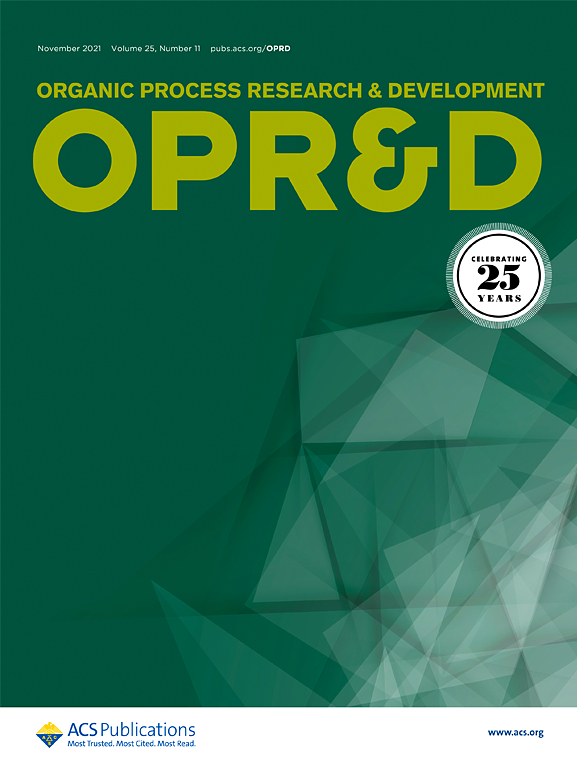利用 THP 乙醚定向正锂化技术获得酚类哒嗪酮和酞嗪酮
IF 3.1
3区 化学
Q2 CHEMISTRY, APPLIED
引用次数: 0
摘要
报道了苯酚取代吡啶吡啶嗪酮(azaphthalazinones)和邻苯二嗪酮的路线探索、工艺研发和大规模合成。为了引入我们的关键组成部分之一,3-(三氟甲基)苯酚,我们确定的大规模路线最初采用不稳定的芳基锂,由溴锂交换产生,紧邻一个被对甲氧基苯基(PMB)醚保护的酚羟基。我们发现,相反,在无溴底物中保护酚羟基作为四氢吡喃(THP)醚,并应用定向邻位金属化(DoM),以稳定的形式生成所需的芳基锂,适合大规模批量使用,这大大促进了我们目标分子的合成。最后的过程是无钯、伸缩的两步序列,包括与混合二酯酰化形成酮和与肼环化,在我们的千克实验室中以0.5千克的规模为吡啶吡啶酮支架进行了演示。我们还研究了类似的苯二嗪酮支架的制备途径,在这里,苯二酸酐和混合二酯都可以作为起始材料。DFT计算支持我们关于实验发现的吡啶和苯基中间体之间差异的基本原理。靶分子被分离为结晶固体,并通过单晶x射线衍射进一步证实了其结构。本文章由计算机程序翻译,如有差异,请以英文原文为准。

Access to Phenolic Pyridopyridazinones and Phthalazinones Using THP Ether-Directed Ortho Lithiation
Route scouting, process research and development, and large-scale synthesis of phenol-substituted pyridopyridazinones (azaphthalazinones) and phthalazinones are reported. For the introduction of one of our key building blocks, 3-(trifluoromethyl)phenol, our identified large-scale route initially employed an unstable aryllithium, generated by bromine lithium exchange next to a phenolic hydroxy group protected as p-methoxybenzyl (PMB) ether. We found that instead, protecting the phenolic hydroxy group as tetrahydropyran (THP) ether in a bromine-free substrate and applying directed ortho metalation (DoM) generated the desired aryllithium in a stable form, suitable for use in a batch process on a large scale, which significantly facilitated the synthesis of our target molecules. The final process, a palladium-free, telescoped two-step sequence consisting of ketone formation by acylation with a mixed diester and cyclization with hydrazine, was demonstrated in our kilogram laboratory on a 0.5 kg scale for the pyridopyridazinone scaffold. Routes to the analogous phthalazinone scaffold were also investigated, and here, both phthalic anhydride and a mixed diester can serve as starting material. DFT calculations support our rationale regarding experimentally found differences between pyridine- and benzene-based intermediates. The target molecules were isolated as crystalline solids, and their structures were further confirmed by single crystal X-ray diffraction.
求助全文
通过发布文献求助,成功后即可免费获取论文全文。
去求助
来源期刊
CiteScore
6.90
自引率
14.70%
发文量
251
审稿时长
2 months
期刊介绍:
The journal Organic Process Research & Development serves as a communication tool between industrial chemists and chemists working in universities and research institutes. As such, it reports original work from the broad field of industrial process chemistry but also presents academic results that are relevant, or potentially relevant, to industrial applications. Process chemistry is the science that enables the safe, environmentally benign and ultimately economical manufacturing of organic compounds that are required in larger amounts to help address the needs of society. Consequently, the Journal encompasses every aspect of organic chemistry, including all aspects of catalysis, synthetic methodology development and synthetic strategy exploration, but also includes aspects from analytical and solid-state chemistry and chemical engineering, such as work-up tools,process safety, or flow-chemistry. The goal of development and optimization of chemical reactions and processes is their transfer to a larger scale; original work describing such studies and the actual implementation on scale is highly relevant to the journal. However, studies on new developments from either industry, research institutes or academia that have not yet been demonstrated on scale, but where an industrial utility can be expected and where the study has addressed important prerequisites for a scale-up and has given confidence into the reliability and practicality of the chemistry, also serve the mission of OPR&D as a communication tool between the different contributors to the field.

 求助内容:
求助内容: 应助结果提醒方式:
应助结果提醒方式:


